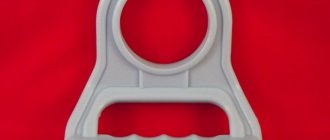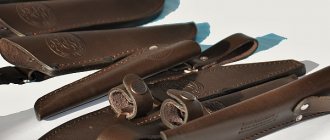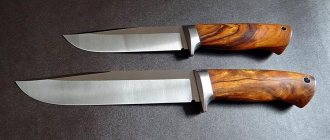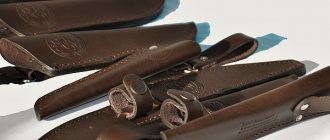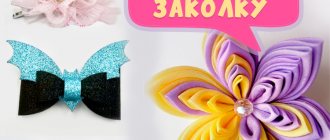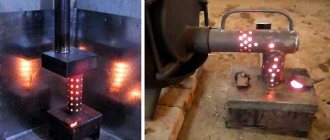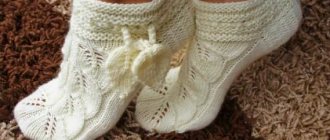The features of the Yakut knife are simplicity, ease of use and wide functionality. Yakut hunting knives can be useful for cutting fish, meat, or, if necessary, repairing something. Archaeological excavations show that in ancient times the ancestors of modern Yakuts used knives of a similar design, so we can say that the secret of the Yakut knife is passed down from generation to generation.
Nowadays, the Yakut knife is not only the personification of culture and history - it is widely used for a variety of purposes. It is difficult to find a Yakut family that does not have at least one traditional knife. A good knife for a Yakut hunter is his closest and most faithful friend. Hundreds of craftsmen throughout Yakutia are engaged in the production of Yakut knives. Therefore, there are many versions that imply a variety of its forms and features. Not everyone can make a Yakut knife with their own hands. Traditionally, they are not purchased ready-made, but are ordered individually. The master takes into account the wishes of the future owner - he will never want to be sold another one that is somewhat similar instead of a national instrument. Thus, a synthesis of the traditional and the individual is formed. Each Yakut knife has its own unique features, but they do not go beyond historical standards.
Drawings and dimensions
The sizes of the Yakut knife, due to its wide functionality, have a very wide range - from the smallest to the very large. Drawings of a real Yakut knife are not so easy to find, because the secret of its correct manufacture is carefully kept. General sizing information is given below.
According to manufacturing style and application, they are divided into twelve varieties:
- Oyuu bychchata - used for applying drawings (patterns) on wooden products. The length of the blade is 3-5 cm.
- Otohut bychchata - used by a doctor, healer, with a very thin and sharp end of the blade. Usually 3-7 cm.
- Wal o kychchanar bygychchata - a knife for a boy. Blade length 7-11 cm.
- Die-wat bykha - a homemade knife. Length 9-14 cm.
- Tabagyt bygaqa - used for cutting a deer carcass (reindeer herder's knife), the tip is very thin and beak-shaped. The blade is thin, one might say “delicate”. Length 9-12 cm.
- Kyra bult bykha - a small hunter's knife. The blade is 9-14 cm long. Soft hardening.
- Balyksyt bykha - fisherman's knife. The blade is wide, the spine is thin, the tip is slightly curved upward. The handle is made of birch bark.
- Bullt bull is a hunting knife. 15-18 cm.
- Mas uuhun bygychchata - used by cabinet makers. For cutting shaped parts of furniture and other wooden products. Length up to 12 cm.
- Mas uuhun bygakha - also for the cabinetmaker. For processing large parts, with a wide, thin blade. Strongly hardened.
- Badaai is a large knife. Up to 25 cm.
- Bolo bykhakh - even larger and heavier, blade length up to 30 cm. These two types of knives are long, designed for heavy work. For example, for butchering large animals, for cutting through ice, for cutting willows, overgrowth, etc.
In general, the dimensions of a Yakut knife can be divided in the following order:
- If the blade length is from 8 to 11 cm, then it is a small knife. It is called “bykychcha” and is made for children and women. However, there are a number of problems that are easier to solve with a knife with a small blade. Therefore, it can conditionally be classified as economic.
- A knife with a blade length from 11 to 17 cm is the most common. It is called “bykhakh” and is used for a variety of purposes.
- A longer blade - above 17 cm makes it a military weapon. It is called “khotonokh” and is made quite rarely.
There are also knives with a longer blade size, which already belong to the type of axes and spears. For example: the Yakut batas or the Yakut batyya, the length of their blade is 40-60 cm. This is a beautiful, light military weapon, once loved by the Yakuts. They could both stab and chop.
In the classification of the Yakut knife, the width of the blade also plays a role. If it is narrow, then it is classified as tundra. This makes it easier to cut something or make holes in something, which is what is primarily needed in tundra conditions. The taiga Yakut knife is intended for cutting hunting trophies or livestock, as well as for processing wood. It is easier to carry out such work with a knife with a wider blade.
Blade
The blade of the Yakut knife is asymmetrical. The butt is straight, even, and the blade is sharp. On the right side there is a dol. It can have a variety of shapes. Some craftsmen prefer to make a notch almost over the entire area of the side of the blade, leaving only a small edge near the butt, while others limit themselves to a groove that is shifted closer to the handle. In the same direction, the fuller can be wider, and towards the “nose” of the blade it narrows. This notch is called "yosom".
Yos arose for several reasons. Firstly, with it the Yakut knife resembled those that their ancestors made from bones. The notch is simply a tribute to tradition; it represents the natural opening for the bone marrow. From the technological side, it once arose as a compensatory leash when connecting, during the process of forging and hardening, soft and hard iron. Secondly, Yos simplifies sharpening and sharpening a knife in the cold and, although for some reason this is rarely talked about, it plays the role of a regular bloodstream, which is present on most combat knives.
The shape of the Yakut knife, the presence of an unsharpened, smooth side of the blade, which is called “bykhakh haptagaya,” enhances the piercing effect, which makes it possible to deliver piercing blows to animals with thick skin, as well as to pierce or drill the skin with a knife.
Today, only real masters know the true secrets of making a Yakut knife. Those copies that are distributed in central cities are far from the original. Typically, a Yakut knife is forged from soft steel. It’s easier to sharpen such a blade on anything—any suitable stone. It cannot be said that modern options involving the use of damask or Damascus steel have any negative properties. They just do not correspond to historical realities, which have always put practicality first.
Second feature
The right side of the blade is usually absolutely straight, with a longitudinal groove in the center. The presence of a fuller on one side of the blade is another feature of the Yakut. Craftsmen make knives with a short and thin fuller or a wide one along the entire length of the blade. The Yakuts call it Yos. The appearance of this feature is explained in different ways. The first version of the origin of such a detail is associated with the original material for making the knife from bone cut lengthwise. And the groove is nothing more than a hole from the bone marrow.
Another option: Yakut knives were made from two components. The base is made of soft iron, the hard part is for the blade. This was done to save durable steel. The groove in this case was like a compensatory leash, which appeared during the process of hardening the two components of the blade.
The flat right side plays an important role. It brings the cross-section of the blade closer to a quadrangular shape. Working with wood or sewing leather clothes requires force. The punching effect is enhanced by this special shape of the Yakut knife.
Handle
The handle of a Yakut knife is made from a single piece of birch burl - essentially a very strong wood, which is impregnated with oils. In cross section, the handle has the shape of an egg. This shape was chosen so that during some work the knife does not rotate in the hand.
The method of mounting the blade into the handle is interesting. First, a wide central hole is made and the pointed shank is driven into the handle. Then wedges made of soft wood are inserted on the sides of the blade. They are bursting, and they clamp the blade in the handle. In order to protect the wooden handle from moisture, it is impregnated with special oils.
The narrow side of the handle is directed towards the blade. The length of the handle is always greater than the length of the blade and the width of a man's palm. Usually it is 130 - 150 mm.
Firstly, in this way even a knife with a blade length of less than 110 mm turns into a weapon. The long handle allows you to deliver a range of strikes that would otherwise be much more difficult to execute.
Secondly, with such a handle it is much more convenient to cut up the carcasses of hunted animals.
Thirdly, a knife with a long handle will not sink in water - it will act as a float. The Yakut knife does not have any additional elements - guards, stops, etc.
Sheath
The sheath of the Yakut knife is simple and functional. They are made from an oxtail, removed with a stocking, and a wooden insert inserted into it. The Yakut knife is recessed into a leather sheath 1/3 of the handle and is fixed there due to friction. The blade hangs freely in a wooden insert inside the scabbard.
This makes it possible to freely insert and remove a knife with a blade on which blood and fat freeze when cutting game in winter. By the way, a real Yakut knife can be removed with one hand, resting your thumb on the mouth of the sheath. The sheath is worn on the belt, on a free suspension from a leather strap in an inclined or horizontal position.
In the old days and today it is acceptable to use sheaths made from sewn pieces of leather. Once upon a time, birch bark was also used, very rarely only wood.
What is a gutter for?
There are several reasons for the relevance of the valley. In addition to saving iron, there are also practical indicators. In Yakutia, frosts below 30-40 degrees Celsius are not uncommon. A knife without a fuller is difficult to sharpen and edit. The fuller blade is thinner, very sharp, and holds an edge well. You can sharpen it quickly and easily.
When cutting a carcass, a wide groove allows the knife to come into contact with the meat only with the back side. The gutter remains free, the skin from the animal is easier to remove due to the reduction of the contact area. Blood flows freely through the recess in the blade.
The presence of a gutter allows you to lighten the weight of the product. When a craftsman forges a Yakut knife, he tries to make it light so that it does not sink in water. The fisherman, having dropped the knife from his hands, is sure that he will not drown, or at least not immediately go to the bottom. A special handle helps you stay afloat.
Sharpening
Sharpening of a Yakut knife is done from the fuller side (on the right for a right-handed person, on the left for a left-handed person). You should apply the block to the cutting edge at a slight angle (<5°) and sharpen the blade from top to bottom (in the direction from the butt to the edge) until a thin shiny line appears on the cutting edge. This line is called “kylaan” in Yakut and is the sharpest part of the cutting edge.
Some experts claim that this is a burr and should be removed, but you should not listen to them; most likely, they do not know how to sharpen a Yakut knife correctly. "Kylaan" should have a slight angle to the left side of the blade. It is strictly forbidden to sharpen a Yakut knife on the left - it has a one-sided sharpening. On the left, it is only allowed to slightly (extremely carefully) adjust the “kylaan” when it bends.
Sharpening is carried out as the “kylaan” disappears. To do this, you need to have several bars with different grain sizes. Grind from coarse to fine.
Do not stir the coals with a Yakut knife or heat the blade excessively. In this case, a release will occur - the blade will become soft. For the same reason, you cannot sharpen a blade on an electric sharpener.
Handle of a Yakut knife
To make it, a small block of wood is suitable, in the end of which you will drill a hole for the shank. What follows is some pretty dirty work, so it is recommended to cover the polished blade with masking tape. When this task is completed, the turn of three important stages comes:
- selection of choppers for tight fixation of the shank in the block and dilution of epoxy with sawdust;
- assembling the knife (insert the shank, pour in the resin and drive in the wood chips);
- marking the center lines of the future handle.
That's all for now - the workpiece must rest for a day for the resin to harden. Well, after this time, all that remains is to give the handle the desired shape in any convenient way.
Wearing and using
A leather strap or cord is threaded into the sheath. With its help, the Yakut knife is attached to the belt, on the left side and with the blade to the left. This makes it possible for a right-hander to grab it quickly. Of course, left-handers carry a knife on the right. The suspension is free so as not to interfere with movements.
It should be understood that the “bykhakh” with a notch and a forged blade length of 110 mm is a real weapon. And its production, distribution and carrying is a matter that is reflected in the Criminal Code. This was the case during the times of the RSFSR, when “bykhakh” was outlawed. True, possessing a knife did not entail any serious consequences. In modern Yakutia, this is regulated by a separate act of the government of the Republic of Sakha.
The Yakut knife is recognized as part of the culture of the Sakha people, and its storage and use in everyday life, sale to tourists and demonstration during public events are allowed on the territory of the republic. Handmade Yakut knives not only become exhibits at folk art exhibitions, but are also widely used in everyday life, during hunting, fishing, and various housework.
Significance of the invention
Modern craftsmen, while observing all traditional requirements, make a Yakut knife, the design of which is passed down from generation to generation. The hope that the invention will not become obsolete, and the fire of love of the masters will be passed on to descendants, is very great. Modern experts of edged weapons highlight this knife with a universal and unique design.
The philosophical basis of the knife is to use it only for creativity and work. The master creates his product as an assistant, and not for war or harm.
In Yakut families, a child from the age of five received a knife. The mothers were not afraid that the boy would get hurt. The first blood and a small cut taught the baby to be careful, careful, and therefore rational. The first knife was made specifically for a child's hand.
A man should have several knives: for household purposes, for woodworking and for hunting. On special occasions, an elegant knife was worn, which emphasized the status of its owner. On ordinary days it hung above the bed. None of the household members had the right to touch him. The family heirloom was inherited by the eldest of the sons.
Where can I buy?
You can buy a real Yakut knife in specialized stores or directly from local craftsmen in Yakutsk. Each copy has its own documents and licenses. Prices vary from 4,000 rubles to 20,000 rubles.
You can buy a Yakut knife not only in Yakutia, but also beyond its borders. Knowledgeable people give preference to factory samples in this matter. In factory production, the product manufacturing process is streamlined, rejects and deviations from forging traditions are minimized.
Samples of Yakut knives, made individually by local craftsmen, have a unique design, but for this the price of such knives is several times higher.
History of appearance
The need for a hunting knife for the Yakuts is dictated by their living conditions. A knife, along with other types of weapons, is a must-have tool for any hunter. Since ancient times, the local population hunted, thus obtaining food and warm skins.
Archaeological excavations provide an indication of the centuries-old history of edged weapons in Yakutia. Moreover, modern products differ little in size and geometry from ancient samples.
Iron ore has been mined in Yakutia since ancient times. Steel was smelted without going through the cast iron stage. The resulting metal was processed by local blacksmiths. Yakut craftsmen learned to make hunting knives with their own hands. Moreover, the knives they made were in no way inferior in quality to the work of blacksmiths in European countries.
Photo
Below are photographs of Yakut knives by famous Yakut masters:
